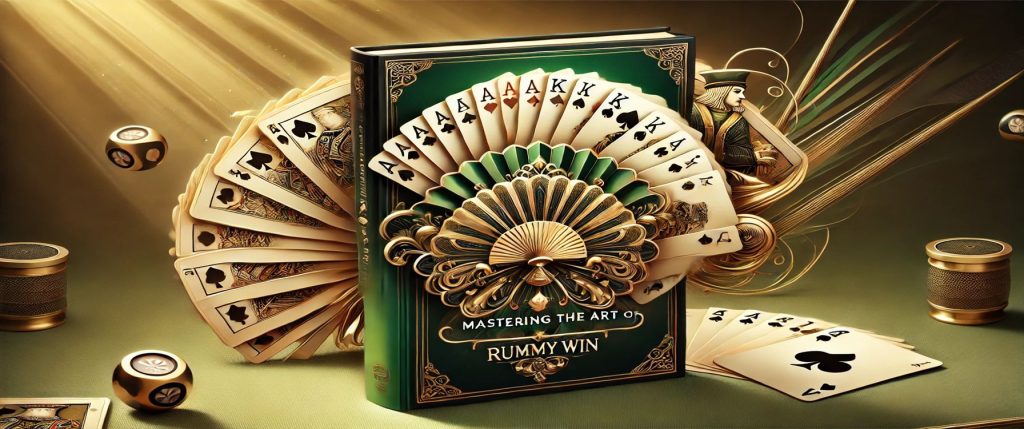Description

Mastering Rummy: An All-Inclusive Guide Rummy is a traditional card game that has enthralled players for many years. It is a fun hobby for both casual players & competitive players due to its unique combination of skill, strategy, and a little bit of luck. Anyone who wants to fully enjoy the game of rummy must have a basic understanding of the game. Rummy’s basic objective is to merge all of your cards before your opponents do, which is accomplished by creating sets & runs from a hand of cards.
A run is a series of three or more cards in the same suit, whereas a set is made up of three or four cards of the same rank but different suits. Two or more players can play the game, & there are several variations with different rules & subtleties. A predetermined number of cards—usually seven or ten, depending on the variation—are dealt to players to start playing Rummy. One card is turned face-up to form a discard pile, while the other cards form a draw pile.
Before discarding one card from their hand, each player takes a turn drawing from the draw or discard pile. Until a single player successfully melds every card in their deck, the round is over. Depending on the version being played, scoring can change, but in general, players receive points for melded cards & penalties for unmelded cards in their hands. Comprehending these essential elements establishes the foundation for creating increasingly complex tactics and enhancing your gameplay in general. Following your mastery of the fundamentals of rummy, the next stage is to create a winning strategy that will enable you to outplay your rivals.
A successful approach frequently depends on flexibility & close observation. Keeping a close eye on the cards your opponents are picking up & discarding is a crucial component. Making educated decisions about which cards to keep or discard can be aided by this information, which can offer insightful information about their possible hands. For example, it might be a sign that an opponent is planning to form a run or set if you observe that they routinely select cards from the discard pile that correspond to a particular suit or rank. By identifying these trends, you can modify your approach to either obstruct their progress or concentrate on finishing your own melds.
Effectively managing your own hand is another essential component of creating a winning strategy. This entails knowing when to hold onto and release particular cards in addition to creating sets & runs. Holding onto high-value cards in the hopes of creating a meld is a common mistake made by inexperienced players, and it can backfire if an opponent declares Rummy before they have a chance. Instead, focus on flexibility & take into account the hand’s overall composition.
Instead of obsessing over a single combination, try to generate several possible melds. By using this strategy, you can adjust to shifting conditions during the game and improve your chances of winning. For any Rummy player hoping to improve their skills, it is essential to recognize important patterns and card combinations. Based on the cards they currently hold and those that have been played, seasoned players frequently acquire an intuitive understanding of which combinations are most likely to result in success. For instance, you might be about to finish a run if you have multiple cards from the same suit in succession.
On the other hand, you may be getting closer to forming a set if you contain several cards of the same rank but different suits. By comprehending these patterns, you can predict your opponents’ moves in addition to spotting possible melds. Also, strategic planning requires an understanding of the different card combinations that can result in victory.
The flexibility and expansion potential of certain combinations make them more advantageous than others in rummy. There are chances for both sets and runs, for example, when you hold a mix of high-ranking and low-ranking cards. Also, keep in mind that wild cards are crucial in some variations of Rummy; they can drastically change your strategy by enabling you to make melds that would not be possible otherwise. Gaining proficiency in identifying these patterns & combinations will improve your gameplay and raise your winning odds. Although it is frequently underutilized in rummy, the discard pile can be an effective tool if used properly.
Gamers should always be aware of which cards are being discarded and how they can take advantage of this knowledge. For example, it might be wise to pick up a card that your opponent has discarded rather than drawing from the pile if you see that it might help you finish your own meld. This helps you move closer to declaring rummy while also denying your opponent a vital card that could help them with their own plan. Also, you can use the strategic discarding of cards as a defensive strategy against your opponents. Consider discarding a card if, from what you’ve seen during gameplay, it is unlikely to benefit anyone else in order to reduce the possibility of giving your opponents an advantage.
On the other hand, consider carefully before discarding a card that might improve an opponent’s hand. The way you use the discard pile can greatly affect the game’s flow and increase your chances of winning if you are deliberate about what you pick up and what you let go. Since it directly affects your ability to form melds and eventually declare Rummy, good hand management is essential in the game. Throughout the game, evaluating your hand composition frequently is a useful tactic. As you draw new cards & discard others, consider which combinations are starting to emerge and which are losing their viability. You can make well-informed decisions about which cards to prioritize & which to put back into play thanks to this continuous assessment.
It might be time to let go of some cards in favor of drawing new ones, for instance, if you discover that they are routinely not adding to any possible melds. Keeping your approach flexible is a crucial component of hand management. Try to always have a variety of options available rather than becoming obsessed with a single meld or combination. Because of your flexibility, you can quickly change your strategy depending on the cards you draw or your opponents’ moves.
For example, be prepared to adjust your focus if you were originally planning to form a run but ended up drawing more cards that could finish a set instead. Effective hand management and staying receptive to new ideas will improve your chances of successfully melding all of your cards before your opponents do. One crucial skill that can make or break your success in the game of rummy is knowing when to declare. Time is crucial; if you declare too soon, you risk losing points if you have unmelded cards in your hand, but if you wait too long, your opponents may catch up or even declare before you. As a general rule, you should declare when you have successfully formed every conceivable meld with the fewest number of unmelded cards remaining in your hand.
This calls for awareness of what your opponents might be holding in addition to self-assurance in your own hand. Also, when determining whether to declare Rummy, take the current state of play into account. It might be time for you to declare if you’ve noticed that opponents are having trouble forming their own melds or appear hesitant in their moves. On the other hand, you might want to wait until you’re more confident in your own hand’s strength if you’ve observed that they are moving quickly toward their own declarations. In the end, developing the timing of Rummy declarations requires striking a balance between confidence and astute observational abilities.
A crucial quality for any successful rummy player is the ability to remain composed under duress. As players approach the endgame, when the stakes feel higher than ever, the competitive aspect of the game can cause elevated emotions. On the other hand, remaining composed during stressful situations enables more rational thought and improved decision-making. More strategic results can result from pausing to think things through & evaluate the situation when faced with difficult decisions, like whether to draw from the deck or pick up a card from the discard pile. Also, maintaining composure during gameplay can affect how opponents view you.
They may question their own tactics or become unduly cautious in their moves if they perceive that you are unfazed by pressure or setbacks. This psychological factor may be advantageous to you since it fosters an atmosphere that increases your likelihood of making wise choices, whereas others may struggle under pressure. By engaging in mindfulness exercises or just reminding yourself of how much fun playing rummy is, you can improve both your performance and overall experience. In conclusion, as with any skill-based game, mastering Rummy requires practice.
Playing the game with friends or family on a regular basis exposes you to a variety of playing techniques & styles that can improve your comprehension of the game while also serving to reinforce what you’ve learned. To interact with a wider variety of players and test your skills against different skill levels, you should also think about joining online Rummy competition platforms. Note what works and what doesn’t for you as you practice; this self-reflection will allow for ongoing development over time. You might find it useful to write down specific games, including which tactics worked, what went wrong, and how various opponents attacked the game.
You will become a more proficient player of Rummy and develop a greater understanding of this classic card game by honing your skills via constant practice and analysis. To sum up, learning Rummy necessitates a combination of core knowledge, strategic approach development, pattern recognition, effective hand management, knowing when to declare victory, remaining composed under pressure, and consistent practice. By adhering to these guidelines & consistently improving your abilities, you’ll discover that you not only love the game more but also succeed at the table more.


